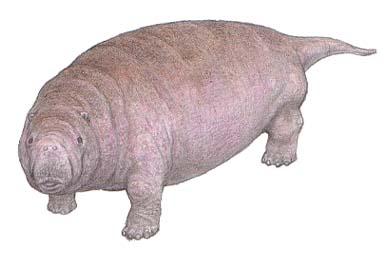Post by Infinity Blade on Jan 4, 2016 4:23:36 GMT 5
Pezosiren portelli

Reconstruction of Pezosiren.
Temporal range: early Middle Eocene (Ypresian; ~50Ma[1])
Scientific classification:
Life
Domain: Eukaryota
(unranked): Unikonta
(unranked): Opisthokonta
(unranked): Holozoa
(unranked): Filozoa
Kingdom: Animalia
Subkingdom: Eumetazoa
(unranked): Bilateria
Clade: Nephrozoa
Superphylum: Deuterostomia
Phylum: Chordata
Clade: Olfactores
Clade: Craniata
Subphylum: Vertebrata
Infraphylum: Gnathostomata
Clade: Eugnathostomata
Clade: Teleostomi
Clade: Euteleostomi
Clade: Sarcopterygii
Clade: Rhipidistia
Clade: Tetrapodomorpha
Superclass: Tetrapoda
Clade: Reptiliomorpha
Clade: Amniota
Clade: Synapsida
Clade: Eupelycosauria
Clade: Sphenacodontia
Clade: Sphenacodontoidea
Order: Therapsida
Clade: Eutheriodonta
Suborder: Cynodontia
Clade: Epicynodontia
Infraorder: Eucynodontia
Parvorder: Probainognathia
Superfamily: Chiniquodontoidea
Clade: Prozostrodontia
Clade: Mammaliaformes
Class: Mammalia
Clade: Holotheria
Superlegion: Trechnotheria
Legion: Cladotheria
Sublegion: Zatheria
Infralegion: Tribosphenida
Subclass: Theria
Clade: Eutheria
Infraclass: Placentalia
Subcohort: Exafroplacentalia
Magnorder: Atlantogenata
Superorder: Afrotheria
Clade: Paenungulata
(unranked): Tethytheria
Order: Sirenia
Family: †Prorastomidae
Genus: †Pezosiren
Species: †P. portelli
Pezosiren is an extinct genus of sirenian that lived in what is now Seven Rivers, Jamaica ~50 million years ago.[1] There is only one species, P. portelli.
Habitat and contemporaries:
The siltstones and sandstones Pezosiren's remains were uncovered from are representative of some sort of depositional environment (lagoonal, estuarine, or deltaic). The presence of mollusk genera Campanile, Eovasum, Paraseraphs, and Velates, as well as that of the early rhinoceros Hyrachyus indicates that the sediment was of early Eocene age. An iguanian lizard and possibly a primate were also identified from Seven Rivers sediment.[1]
Description:
Pezosiren had four well-developed limbs for locomotion on land, although it also had aquatic adaptations, indicating an animal that spent most of its time in water. This intermediate lifestyle between a terrestrial and aquatic lifestyle reflects the sirenians' transition from land to water. Unlike extant sirenians, it would not have moved in water with powerful dorsoventral undulations of the tail. Instead, it would have moved with simultaneous pelvic paddling in conjunction with spinal undulation.[1] As clearly shown from a look at its skeleton, Pezosiren's skeleton strongly resembles those of extant sirenians (aside from its limbs).

Skeleton of P. portelli.
Indeed, Pezosiren is in lieu of paranasal air sinuses and was in possession of a prominent rostrum, retracted and enlarged external nares, longitudinally-aligned incisor arcades, substantial pachyosteosclerosis, and there was contact between the premaxilla and frontal, indicating its position within Sirenia. As a sirenian with well-developed limbs and a semi-aquatic lifestyle, Pezosiren helps demonstrate yet another (marked) example of morphological evolution in the vertebrate fossil record.[1]
References:
[1] "The earliest known fully quadrupedal sirenian" (Domning, 2001).
Reconstruction of Pezosiren.
Temporal range: early Middle Eocene (Ypresian; ~50Ma[1])
Scientific classification:
Life
Domain: Eukaryota
(unranked): Unikonta
(unranked): Opisthokonta
(unranked): Holozoa
(unranked): Filozoa
Kingdom: Animalia
Subkingdom: Eumetazoa
(unranked): Bilateria
Clade: Nephrozoa
Superphylum: Deuterostomia
Phylum: Chordata
Clade: Olfactores
Clade: Craniata
Subphylum: Vertebrata
Infraphylum: Gnathostomata
Clade: Eugnathostomata
Clade: Teleostomi
Clade: Euteleostomi
Clade: Sarcopterygii
Clade: Rhipidistia
Clade: Tetrapodomorpha
Superclass: Tetrapoda
Clade: Reptiliomorpha
Clade: Amniota
Clade: Synapsida
Clade: Eupelycosauria
Clade: Sphenacodontia
Clade: Sphenacodontoidea
Order: Therapsida
Clade: Eutheriodonta
Suborder: Cynodontia
Clade: Epicynodontia
Infraorder: Eucynodontia
Parvorder: Probainognathia
Superfamily: Chiniquodontoidea
Clade: Prozostrodontia
Clade: Mammaliaformes
Class: Mammalia
Clade: Holotheria
Superlegion: Trechnotheria
Legion: Cladotheria
Sublegion: Zatheria
Infralegion: Tribosphenida
Subclass: Theria
Clade: Eutheria
Infraclass: Placentalia
Subcohort: Exafroplacentalia
Magnorder: Atlantogenata
Superorder: Afrotheria
Clade: Paenungulata
(unranked): Tethytheria
Order: Sirenia
Family: †Prorastomidae
Genus: †Pezosiren
Species: †P. portelli
Pezosiren is an extinct genus of sirenian that lived in what is now Seven Rivers, Jamaica ~50 million years ago.[1] There is only one species, P. portelli.
Habitat and contemporaries:
The siltstones and sandstones Pezosiren's remains were uncovered from are representative of some sort of depositional environment (lagoonal, estuarine, or deltaic). The presence of mollusk genera Campanile, Eovasum, Paraseraphs, and Velates, as well as that of the early rhinoceros Hyrachyus indicates that the sediment was of early Eocene age. An iguanian lizard and possibly a primate were also identified from Seven Rivers sediment.[1]
Description:
Pezosiren had four well-developed limbs for locomotion on land, although it also had aquatic adaptations, indicating an animal that spent most of its time in water. This intermediate lifestyle between a terrestrial and aquatic lifestyle reflects the sirenians' transition from land to water. Unlike extant sirenians, it would not have moved in water with powerful dorsoventral undulations of the tail. Instead, it would have moved with simultaneous pelvic paddling in conjunction with spinal undulation.[1] As clearly shown from a look at its skeleton, Pezosiren's skeleton strongly resembles those of extant sirenians (aside from its limbs).

Skeleton of P. portelli.
Indeed, Pezosiren is in lieu of paranasal air sinuses and was in possession of a prominent rostrum, retracted and enlarged external nares, longitudinally-aligned incisor arcades, substantial pachyosteosclerosis, and there was contact between the premaxilla and frontal, indicating its position within Sirenia. As a sirenian with well-developed limbs and a semi-aquatic lifestyle, Pezosiren helps demonstrate yet another (marked) example of morphological evolution in the vertebrate fossil record.[1]
References:
[1] "The earliest known fully quadrupedal sirenian" (Domning, 2001).



